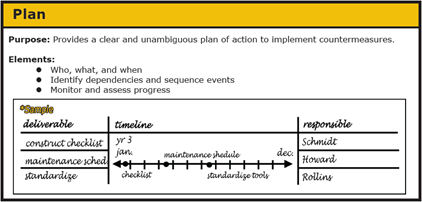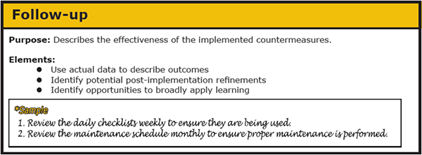
advertisement
Hotel Problems Solved Once and For All
(Part 3 of 3)
Plan
your work. Then work your plan.
|
News for the Hospitality Executive |

advertisement
Plan
your work. Then work your plan.
| by Jim Hartigan July 18, 2011 Welcome to part three of the O3 trilogy! If you’ve followed along in parts one and two, I’m sure you’re anxious to learn about the final two steps in the O3 problem solving cycle…at least until the process begins again. If you missed parts one and two, here is a brief recap. Overview: O3’s seven-step approach to solving business problems, founded on Deming’s PDCA cycle, is designed to equip high-potential employees with the critical thinking skills necessary to truly solve problems. This is done by capitalizing on the learning opportunity present in the problem solving process. At the heart of O3 is a one-page visual (drawing, charts, graphs, words, etc.) depicting the seven-step problem solving process. Throughout the process, key business problems are explored, investigated, and ultimately solved. In the first two parts of our series we discussed the first five steps in the seven step O3 Problem Solving process.
In the final segment to our series, we’ll bring it all home with a look at steps six and seven – your Plan and Follow-up. Plan  Planning is the creation of a
blueprint or roadmap for all organizations.
When done by work teams, plans become an agreement or contract between
teams
and individuals as to what will be completed, by whom and by
when. At its simplest form, the Plan is the “Who
will do What When” document. Plans can
take fancy shapes and sizes like Gantt charts, or they can be as simple
as
three columns – Who, What, and By When – a responsible party, an
action, and a
deadline. For each “Who”, you must
define the “What” (to make absolutely clear the actions to be
accomplished) and
the “When” (to leave no doubt or expectation for completion to
chance). If the work team creates the Plan you’ll gain
maximum buy-in on the tasks and have the chance to gather feedback
about the
timeline. Remember, no task is complete or
measurable without a target completion date (read: deadline). The Plan becomes a
roadmap from the Current Condition (step 2) to the Goal/Target state
(step 3). Planning is the creation of a
blueprint or roadmap for all organizations.
When done by work teams, plans become an agreement or contract between
teams
and individuals as to what will be completed, by whom and by
when. At its simplest form, the Plan is the “Who
will do What When” document. Plans can
take fancy shapes and sizes like Gantt charts, or they can be as simple
as
three columns – Who, What, and By When – a responsible party, an
action, and a
deadline. For each “Who”, you must
define the “What” (to make absolutely clear the actions to be
accomplished) and
the “When” (to leave no doubt or expectation for completion to
chance). If the work team creates the Plan you’ll gain
maximum buy-in on the tasks and have the chance to gather feedback
about the
timeline. Remember, no task is complete or
measurable without a target completion date (read: deadline). The Plan becomes a
roadmap from the Current Condition (step 2) to the Goal/Target state
(step 3).Follow-Up  The Follow-up step is one of
the most important, as its sole aspiration is to evaluate the
effectiveness of
countermeasures and memorialize lessons learned. After
implementing the Plan – what
happened? By what measures can you
determine how the plan worked? Have the
Current Conditions changed? Has the
Goal/Target state been achieved? Maybe
most importantly, what unintended consequences have been encountered by
the
implementation of the plan? As we’ve
noted, the Countermeasure step may very well cause a new problem.
Recognizing this fact and moving your
organization from a “mistakes = failures” mentality to a “discovered
mistakes =
opportunity to learn” mentality is the key to developing a true
appreciation
for continual improvement. The Follow-up step is one of
the most important, as its sole aspiration is to evaluate the
effectiveness of
countermeasures and memorialize lessons learned. After
implementing the Plan – what
happened? By what measures can you
determine how the plan worked? Have the
Current Conditions changed? Has the
Goal/Target state been achieved? Maybe
most importantly, what unintended consequences have been encountered by
the
implementation of the plan? As we’ve
noted, the Countermeasure step may very well cause a new problem.
Recognizing this fact and moving your
organization from a “mistakes = failures” mentality to a “discovered
mistakes =
opportunity to learn” mentality is the key to developing a true
appreciation
for continual improvement.
So there you have it. A straightforward seven step process that will help you and your hotel team stop jumping to conclusions and inefficient “quick-fix” actions and embrace root-cause focused countermeasures developed by work teams in the trenches with accountability, responsibility, and authority to make change and deadlines to do so. Drop us a note and tell us what you think of the O3 Problem Solving Process or if you’d like more information about how to implement the O3 Problem Solving Process with your organization by clicking here. Until next time, remember – take care of the customer, take care of each other, take care of yourself.  About the Author: Jim Hartigan, Chief Business Development Officer and Partner joined OrgWide Services, a Training/e-Learning, Communications, Surveys and Consulting firm in April 2010 after nearly 30 years experience in the hospitality industry, including the last 18 as a senior executive with Hilton Worldwide. Jim’s last position was that of Senior Vice President – Global Brand Services where he provided strategic leadership and business development and support to the $22B enterprise of 10 brands and more than 3,400 hotels in 80 countries around the world. His team was responsible for ensuring excellence in system product quality, customer satisfaction, market research, brand management, media planning, and sustainability. |
| Contact: Jim Hartigan Chief Business Development Officer & Partner OrgWide Services 165 N. Main Street, Suite 202 Collierville, TN 38017 office: 901.850.8190 Ext. 230 mobile: 901.628.6586 [email protected] www.orgwide.com |